
The Crowbar of Cultural Publishing: Introducing the Hybrid Publications Research Group
These are some of the questions that will be explored in the coming 18 months by the Hybrid Publications group of Going Hybrid, which includes Tommaso Campagna (Institute of Network Cultures), Sepp Eckenhaussen (Institute of Network Cultures), Juliette Lizotte (Hackers & Designers), Ashley Maum (Framer Framed), Anna Maria Michael, Ania Molenda, Maria van der Togt (Institute of Network Cultures), and Ebissé Wakjira-Rouw (Framer Framed). Taking the experience of the cultural institution Framer Framed as a starting point, we will do transdisciplinary, practice-based research into hybrid publishing in the arts.
Fortunately, we don’t start from scratch. The promise of new reading experiences is as old as computers and much work in experimental publishing has been done in the arts and culture. A future blog post will present a state-of-the-art assessment of a broad range of relevant practices. The point of departure of this text is the work already being done by the various research partners, complemented by insights from a literature review and interviews with experts. Starting from the crisis of the publishing industry, with a trip into the history of alternative publishing, and an overview of the work of our partners, this text leads to the formulation of concrete research directions for the coming two years.
Stagnation in the Publishing Industry
While printed books remain as popular as ever, developments in soft- and hardware have expanded the horizon of the average reader. On the side of publishers, these developments have been promising as well as challenging. How to make publishing faster, cheaper, and more accessible publications, while keeping the quality at a high level? Publishing novels in print and as ePubs has become the norm, newspapers are published digitally for tablets as well, and e-book and audiobook subscriptions are on the rise.
But these developments have so far failed to live up to the promise of ‘richer’ multimodal reading experiences. The bleak reality is that people are still reading bad scans of poorly designed prints more often than exciting narratives in experimental formats. What’s the last time you saw a moving image in a print book? Fifteen years ago, a state-of-the-art publication would include a CD-ROM with an audio track to accompany the reading. Today, the same book would include a QR code to a Spotify playlist. The medium has changed, but no serious development has taken place. Multi-media and crossover reading got stuck on the level of frivolous extras.
According to David Huijzer, editor-in-chief of INCT.nl, a professional journal for publishers, this failure to live up to the promises of rich reading experiences is largely to do with the structure of the publishing industry. In an interview for this article, he stated: ‘Would it be possible to share content differently? Yes. Should we? Yes. But publishers are hesitant. The industry doesn’t like avant-gardism.’ In Huijzer’s view, this has to do with a lack of an ‘early majority’ public for multi-media products and crossovers. There is simply not enough interest in these products among (paying) readers. Huijzer suspects that these publications are too complex and require too much multi-tasking. Whatever the exact reason is, traditional publishers never bridged the gap to the online media landscape dominated by digital-born publications like blogs, feeds, and (social) platforms such as Substack, authors.me, Manifold, PubPub, and Galatea. By and large, the publishing industry and online media remain separate worlds. As a result, Huijzer observes that ‘it’s not easy to find people who want to experiment, especially in the commercial domain. You won’t be seeing commercial disruptors any time soon.’
The contrast between the inertia of the publishing industry and the experimental cultural publishing field could hardly be bigger. While traditional publishers sit on too much money to move, cultural publishing is usually low-cost, open-source, and aimed at public functions rather than profit. If, in other words, we want to push for new ways of publishing and reading, we have to develop the possibilities ourselves. Let cultural publishing be the crowbar to create space for new reading and interaction formats.
The Cultural Publishing Niche
This is nothing new. Experimental publishing has taken place in subaltern cultural scenes for a long time. In Post-digital Print: The Mutation of Publishing Since 1894 (2012), Alessandro Ludovico has narrated this history of alternative publishing, all the way from Dada experiments to FLOSS Manuals. It is well-known that conceptual artists often take an interest in discursive and publishing practices. Since the rise of the art magazine in the 1960s, and especially the punk zine in the ’70s and ’80s, DIY publishing practices in the arts have proliferated. Today, they form a niche, if not underground, part of the publishing field which fosters experiments with form, content, method, and economic models. At the Piet Zwart Institute (Rotterdam), there is an entire MA program dedicated to Experimental Publishing.
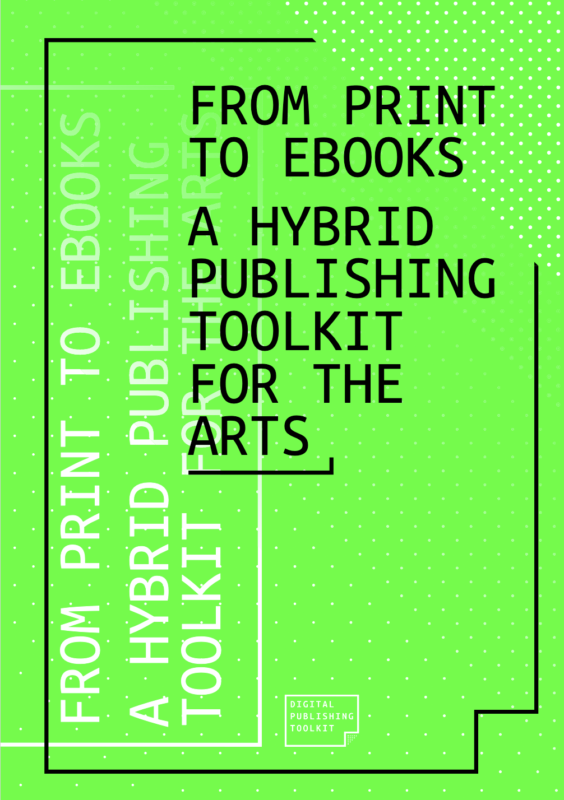
From Print to Ebooks: A Hybrid Publishing Toolkit for the Arts, Amsterdam: Institute of Network Cultures, 2015.
The work of our research group is situated within the tradition of experimental cultural publishing. The Institute of Network Cultures has been involved in contemporary (cultural) publishing experiments for years. From 2013 to 2014, we developed the Hybrid Publishing Toolkit: a workflow for simultaneously publishing books as print-on-demand, PDF, and ePub. This workflow has since been used for the Theory on Demand book series, resulting in 42 hybrid publications – and counting.

Here and Now? Explorations in Urgent Publishing, Amsterdam: Institute of network Cultures, 2019.
From 2018 to 2019, the INC ran the research program Making Public, in which we looked at designing non-linear stand-alone publications, platform2platform content sharing, and automating periodical production processes. The most interesting experiment in this project was probably the publication of the research report, Here and Now? Reflections on Urgent Publishing. In the run-up to the launch of the print publication, the respective chapters were sent to a dedicated mailing list in specially designed emails. This method combined the ancient print book with the good old mailing list and a fresh, highly interactive user experience design into something that felt surprisingly urgent. Miriam Rasch, then coordinator of the research program, remembered that this publication led to a higher rate of responses and interaction with the readership. It’s usually rare to get personal feedback on books because the threshold to send a letter or email to the author or editor of a print book is quite high. But readers of the Urgent Publishing mailing list could simply reply to the email in their inbox chapters with their personal comments.

An impression of a chapter from Urgent Publishing?, pre-published as an email.
The Covid Pressure Cooker
Digitization of cultural programs was accelerated by Covid. The necessity to engage with hybrid spaces, publics, and classrooms during the pandemic acted as a pressure cooker for the ongoing redefinition of cultural publishing processes and reading experiences in the digital era. In a future blog post, a hand-picked, definitively unexhaustive selection of best practices on hybrid publications will be discussed. Here, the focus is on the work that the members of our research group have been doing in the past two years and the expertise we have on board, specifically looking at Varia, Hackers & Designers, Maria van der Togt, and Ania Molenda.
Recently, Varia has started publishing the hybrid, bilingual newsletter SomeTimes / Af en toe. The contents are created collectively by the members of Varia in OctoMode and published as .pdfs and flyer-like prints. The format of these newsletters is a direct expression of the collective working process Varia uses. According to Simon Browne, contingent librarian and member of Varia, it cost some time to set up the template, but it’s pretty simple in its use. The .pdf newsletter is a seamless extension of the Varia website, spreading news on events and projects to the collective’s (international) network of cultural workers, geeks, and organizers. The print version, which feels like a crossover of a flyer and a local newspaper, allows for a bigger presence in the Rotterdam neighborhood. This reflects a tendency within Varia during the lockdowns, to not go online, but to focus on the hyperlocal and provide a community space. Urgent, hybrid publication in the arts doesn’t always equal digitization, but rather an adaptive workflow and method that allows for the right hybrid format according to needs.
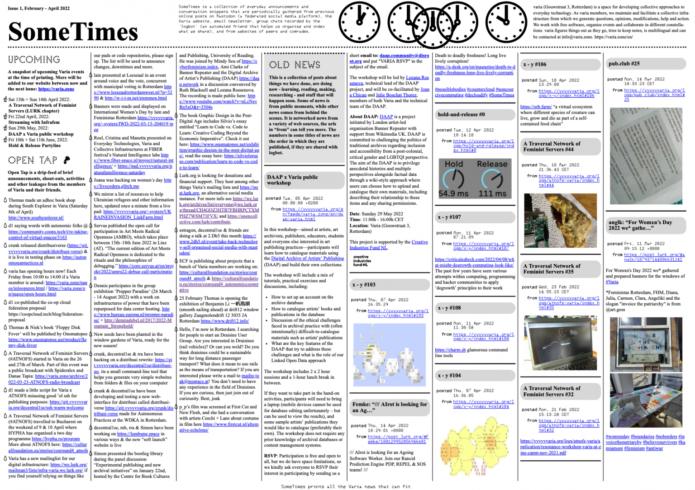
SomeTimes as a digital newsletter.
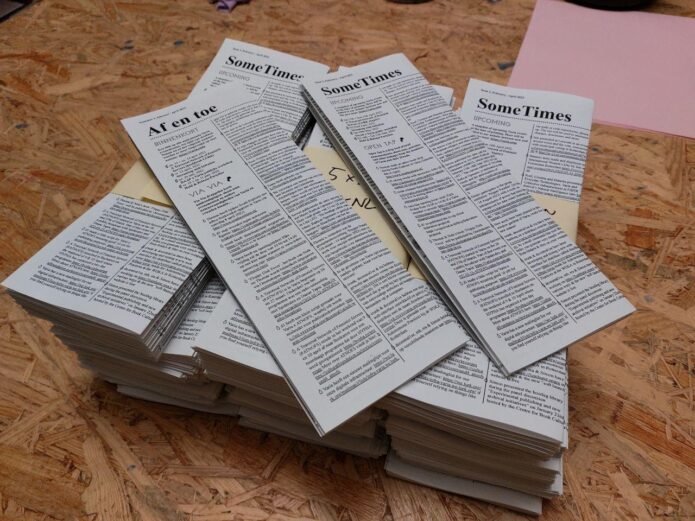
SomeTimes as a print newsletter.
Taking the directness of collaborative editing-to-publication conversion a step further, Hackers & Designers are building ChattyPub, a publication design tool in the making. The application leverages the chat interface of Zulip to apply styles and formats to the content of a publication. Concretely, this means that every text sent in a chat is automatically added to the front-end publication. The primary output of ChattyPub is a web publication, but automated print versions of the files can be generated, turning the chats into hybrid publications. ChattPub was even used to create the manuscript of the self-published book Network Imaginaries.
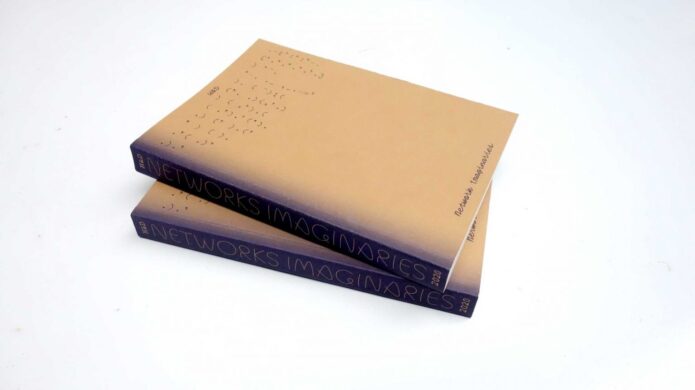
Network Imaginaries, self-published by Hackers & Designers, edition of 250, Amsterdam, 2021.
 The use of ChattyPub requires chatters-authors to use basic coding, so it is not intuitively useable for anyone. However, with a little teaching, it’s a very low-threshold way of playfully publishing together with surprising outcomes such as this one, this one, and this one. With ChattyPub workshops, Hackers & Designers teach participants to use the tools and, ideally, create a publishing community in the process.
The use of ChattyPub requires chatters-authors to use basic coding, so it is not intuitively useable for anyone. However, with a little teaching, it’s a very low-threshold way of playfully publishing together with surprising outcomes such as this one, this one, and this one. With ChattyPub workshops, Hackers & Designers teach participants to use the tools and, ideally, create a publishing community in the process.
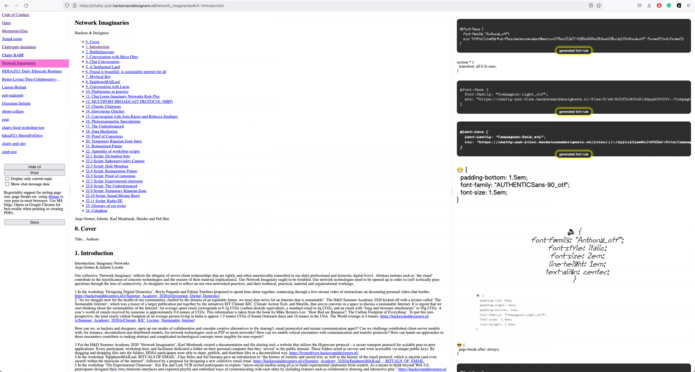
An impression of the ChattyPub interface.
To question and circumvent paywalls that enclose knowledge that should be public, Maria van der Togt has created the artwork Hard Copy Soft Copy—Impermeable Domains (2021). The work consists of a virtual platform with an open-source collection of digital publications, run on a raspberry pi, and a spatial printing and binding set-up. Members of the public use the on-site computer to select any of the documents and print and bind it on the spot. In rescuing material from the clutches of corporatization, the work upholds the true definition of ‘public’ through the simple gesture of providing resources without any expectation of return.
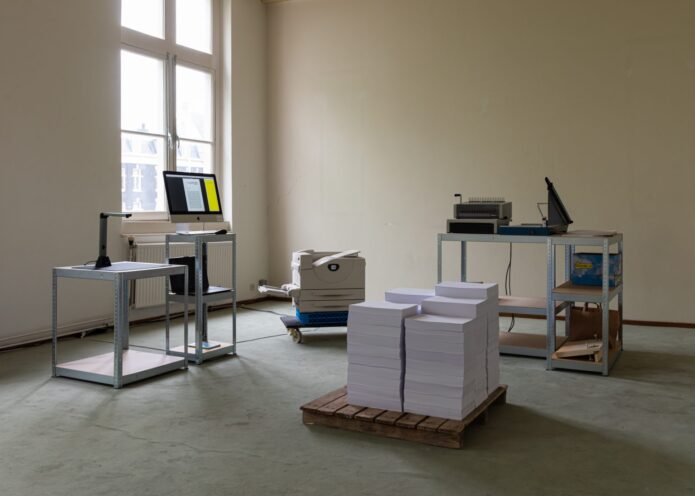
Installation view of Hard Copy Soft Copy – Impermeable Domains (2021) by Maria van der Togt.
The ultimate goal of any of these experiments with format and access is to create a deeper, interactive, surprising, or otherwise more valuable reading experience for a broader audience. However, in the oversaturated media landscape of the internet, readers are expected to have an attention span of about three tweets. This tension, and possible solutions, are explored by Ania Molenda and collaborator Andrea Prins in the project ‘Beyond the Essay. New Ways of Critical Reflection‘. To re-evaluate once emancipatory format of the essay, they research new forms of interactive publishing that stimulate critical reflection and engagement from readers. In a series of interviews with publishers, they searched for affordable and user-friendly solutions, and new ways of dealing with digital content. The results of ‘Beyond the Essay’ will be published soon and shared on this blog.
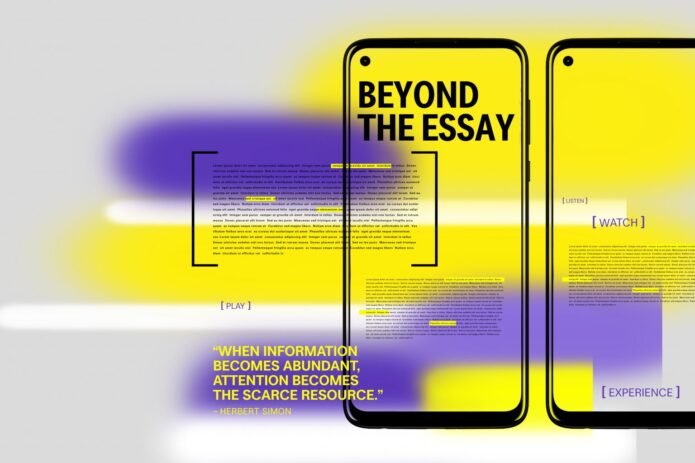
Possible Research Directions
From September 2022 until December 2023, the Hybrid Publications group will convene for regular design sprints, building upon the research and experiments discussed above. We will do research through practice together, and figure out new ways of publishing and reading on the go. Since the design sprint method is per definition a learning process, the outcome is not set. However, we are dedicated to embracing a transdisciplinary approach and creating something together that is useful to all of us. From where I stand now, I can see four possible research directions:
• Real-time transcripts (and other forms of instant publishing). The many online and hybrid cultural programs that are programmed are often not well-documented and disappear into the void of the internet. We need formats and workflows to create fast, half-standardized formats of event reports, like a report zine or flyer-as-book. Building on previous work with tools like Etherpad and Trint, such a format and workflow could be developed within our group.
• Non-linear catalogs. This would not be the first time we developed a workflow. During our previous research project Making Public, we developed a workflow for making non-linear stand-alone publications using Scalar and Twine and created a manual for anyone who’s interested. But while authors might incidentally be interested in non-linear publications, the structural use-value is not so clear. Catalogs might be a very logical type of publication to make non-linear.
• Interactive web publications. There is a widely shared desire to engage with publics in a dialogic, open, multi-voiced way. Interactive web publications with options ranging from open editing to commenting, such as hypothes.is, are the most obvious way to realize this desire through publishing, but it’s a challenging research direction as well. We’re not working with hard-core coders and web developers. Experimental web development has proven in the past to be too unstable for long-term use. Moreover, there is the issue of editorial upkeep, such as troll control and keeping the content and functionalities alive.
• On-demand printing stations. This is a more realistic option to create engagement and personalization between publications and publics. Since we are working in the context of cultural spaces, with three group members with a background in architecture, and one with experience in making a printing station, it would be a promising option to develop an on-demand catalog printing station. On-demand printing would also allow for a customized product: one can order a print of only the parts they will actually read, saving time, space, and natural resources.
• Audio-text hybrids. The technical possibilities of hybrid publications with digital and print text have become quite advanced over the past years. But audio is a new dimension in the realm of hybrid publications. Could a hybrid workflow such as the Theory on Demand-workflow include not only print, web-based, ePub, and .pdf, but also an audiobook?
Subversive Publishing /
Network
